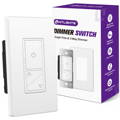These connectors are very well made. The screw mechanism also feels solid when you attach the wires or the light strips.
The screw driver is a little on the cheap side, but since that is not part of the connectors I am still rating the connector 5 stars; I just use my own screwdriver.
The thing I cannot figure out is what the little adhesive stickers are for. I THOUGHT they were to attach the connector, but the stickers only have adhesive on one side, that is, they are not double sided adhesive. See photo.
If you peel the sticker that says "3M" off it is sticky on one side. Once you peel the "3M" sticker off one side underneath there is a white slick paper (no adhesive). You flip that over and the other side is brown and say "3M". You peel that off it is also sticky on one side and you are left with the OTHER side of the white slick paper (no adhesive on this side either). So what you have is a total of three pieces once you have finished peeling everything off. Two pieces that say "3M" and are sticky on side, and one piece that is white and slick paper with no sticky on either side.
None of these items are double sided adhesive, so if someone can tell me what they are for I would appreciate it.
Great experience love the product.
I had this dimmable driver installed for my kitchen cabinet led strip lights. The original driver stopped working after about 2 years and I contacted support as this is warrantied for 6 years. Mr. Meden provided exceptional service and support in getting the replacement shipped to me in no time.
Fantastic people. I'm a Happy Customer.


